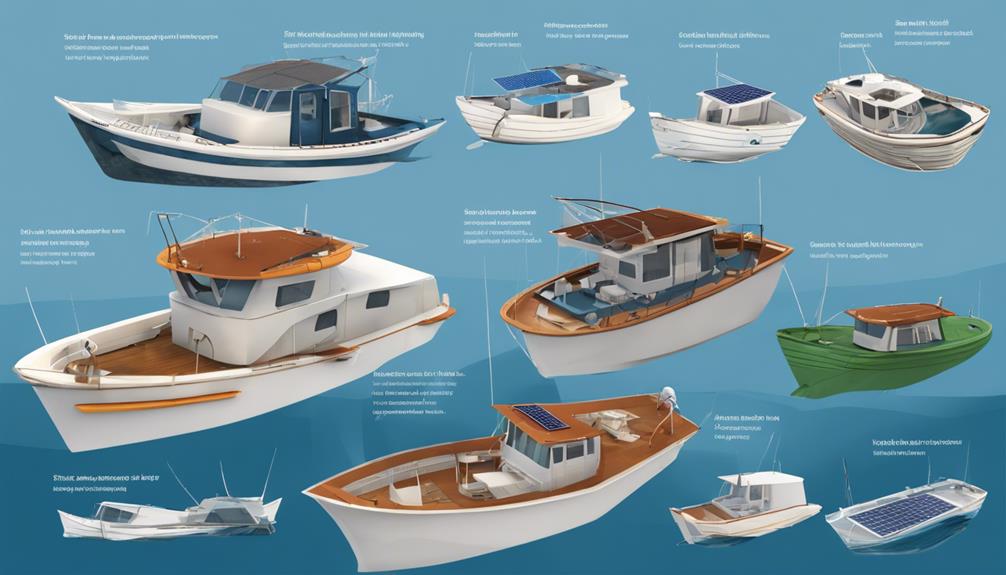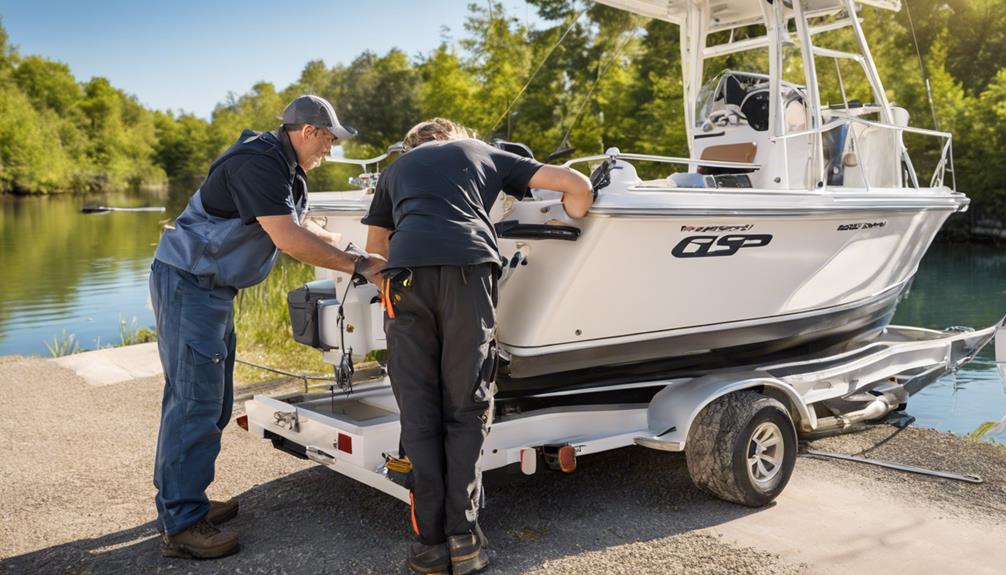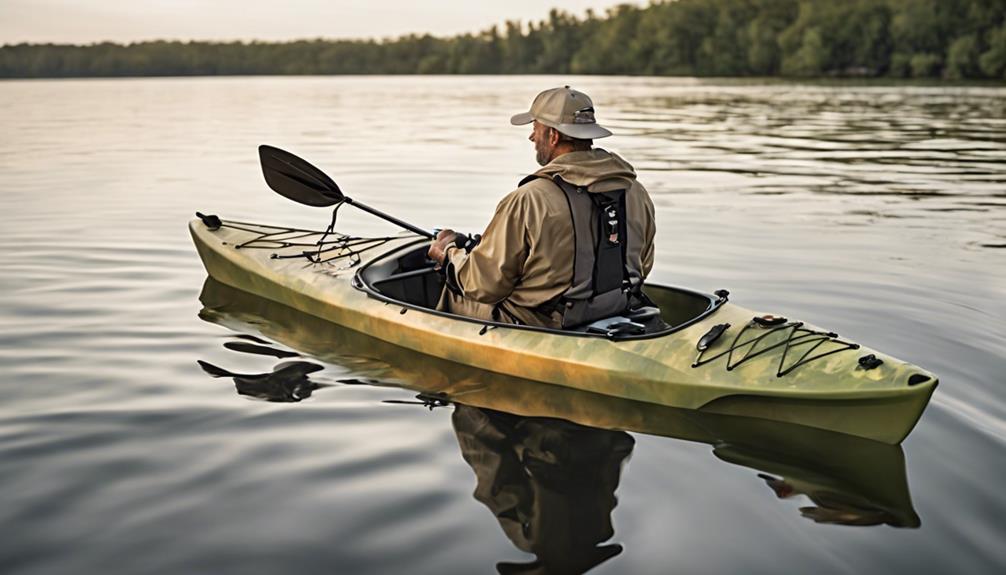Imagine a world where fishing boats not only harvest the ocean but also do so sustainably. What if these vessels were equipped with innovative designs that minimize their environmental impact while maximizing their efficiency?
From solar-powered hulls to automated fish detection systems, the realm of sustainable fishing boat technology is evolving rapidly. Stay tuned to discover how these six cutting-edge designs are revolutionizing the fishing industry and paving the way for a more environmentally conscious approach to maritime activities.
Solar-Powered Hulls
When designing sustainable fishing boats, incorporating solar-powered hulls can significantly reduce reliance on traditional fuel sources. The advantages of using solar power for boat hulls are numerous.
Firstly, solar energy is a renewable resource, meaning it's abundant and can be harnessed without depleting natural reserves. This makes solar-powered hulls a sustainable option in the long term. Additionally, solar panels have low maintenance requirements, reducing operational costs for boat owners. By harnessing the power of the sun, fishing boats can operate with lower emissions, making them more environmentally friendly.
Despite these advantages, there are limitations to consider when using solar-powered hulls.
One limitation is the dependence on sunlight. Fishing boats operating in areas with limited sunlight or during nighttime may struggle to recharge their batteries effectively. This limitation can be mitigated by incorporating battery storage systems or hybrid power sources to ensure continuous operation. Another limitation is the initial investment required for installing solar panels on the hull. While the long-term cost savings are substantial, the upfront costs may deter some boat owners from adopting this technology.
Recycled Material Construction
To further enhance the sustainability of fishing boats, consider utilizing recycled materials in the construction process. Eco-friendly manufacturing practices are becoming increasingly important in the maritime industry. By incorporating recycled materials into the construction of fishing boats, you can significantly reduce the environmental impact of the manufacturing process.
Waste reduction strategies play a crucial role in sustainable boat building. Instead of using traditional materials that contribute to landfill waste, opt for recycled materials such as reclaimed wood, recycled plastic, or repurposed metal. These materials not only help reduce waste but also conserve natural resources by giving a second life to materials that would have otherwise been discarded.
When selecting recycled materials for your fishing boat construction, ensure that they meet industry standards for safety and durability. Many companies now specialize in providing high-quality recycled materials specifically designed for marine applications. By choosing these materials, you can create a sturdy and seaworthy vessel while also supporting the circular economy and reducing your carbon footprint.
Incorporating recycled materials into the construction of fishing boats is a practical and effective way to promote sustainability in the maritime industry. By embracing eco-friendly manufacturing practices and waste reduction strategies, you can play a significant role in protecting the oceans and marine ecosystems for future generations.
Hydrodynamic Shape Optimization
Optimize the shape of fishing boats for improved hydrodynamics to enhance efficiency and performance on the water. When designing fishing boats, focusing on hydrodynamic shape optimization is crucial for efficient energy consumption and reducing the environmental impact of fishing activities. By refining the contours of the boat to minimize drag and resistance as it moves through the water, you can significantly increase fuel efficiency and reduce overall energy consumption during fishing operations.
Efficient energy consumption is essential for sustainable fishing practices, as it not only lowers operational costs but also decreases the carbon footprint of the fishing industry. By incorporating streamlined hull designs and optimizing the overall shape of the boat, you can enhance propulsion efficiency and reduce the amount of fuel needed to navigate the waters effectively.
Moreover, improving the hydrodynamics of fishing boats can have a positive environmental impact by minimizing the disturbance to marine ecosystems. A well-optimized shape reduces the waves and turbulence created as the boat moves, helping to preserve the natural habitat of marine life and maintain the delicate balance of aquatic environments.
Automated Fish Detection Systems
Consider implementing automated fish detection systems on fishing boats to revolutionize the way fish are located and captured at sea. By incorporating machine learning algorithms and underwater robotics, fishing vessels can significantly enhance their efficiency and sustainability practices.
- Machine Learning Algorithms:
Utilizing machine learning algorithms can enable fishing boats to analyze sonar and camera data in real-time, identifying fish species and estimating their abundance with greater accuracy than traditional methods. This technology can help reduce bycatch and target specific species more effectively.
- Underwater Robotics:
Deploying underwater robotic vehicles equipped with advanced sensors can allow fishing boats to explore larger areas and depths, collecting valuable data on fish distribution and behavior. These robots can work autonomously or be controlled remotely, providing valuable insights to optimize fishing operations.
- Integration and Automation:
Integrating fish detection systems with automated fishing gear can streamline the capturing process further. By automatically adjusting net parameters or directing trawling operations based on real-time fish detection data, fishing boats can minimize fuel consumption and habitat disturbance.
Implementing automated fish detection systems onboard fishing boats can't only improve catch efficiency but also contribute to sustainable fishing practices by reducing environmental impact and promoting responsible fishing techniques.
Low-Impact Propulsion Technologies
Enhance sustainability and efficiency on fishing boats by exploring low-impact propulsion technologies. Electric motors are a cutting-edge solution that can significantly reduce the environmental impact of fishing vessels. By replacing traditional diesel engines with electric motors, boats can operate quietly and emit zero harmful emissions into the water, thus preserving marine life. These motors can be powered by a variety of sources, including renewable energy such as solar or wind, further decreasing their carbon footprint.
In addition to electric motors, biofuel options present another eco-friendly alternative for powering fishing boats. Biofuels are derived from organic materials like algae or plant oils, making them a renewable and cleaner choice compared to traditional fossil fuels. By using biofuels, fishing boats can reduce their greenhouse gas emissions and overall environmental impact while still maintaining the necessary power for their operations.
Both electric motors and biofuels offer sustainable propulsion solutions that can revolutionize the fishing industry. By implementing these low-impact technologies, fishing boats can operate more efficiently and environmentally consciously, ensuring a healthier future for our oceans. Make the switch to electric motors or biofuels today and propel your fishing boat towards a greener tomorrow.
Vertical Farming Integration
Implement vertical farming integration on fishing boats to revolutionize sustainable food production at sea. By incorporating hydroponic gardens and aquaponic systems onboard, fishing vessels can enhance their self-sufficiency and reduce their environmental impact significantly.
- Hydroponic Gardens: Utilize vertical space efficiently by growing crops in a soil-less environment. This method conserves water and nutrients, making it ideal for maritime settings where resources are limited.
- Aquaponic Systems: Integrate fish farming with hydroponics to create a symbiotic ecosystem. Fish waste provides nutrients for plants, while the plants filter the water for the fish, resulting in a closed-loop system that maximizes resources.
- Fresh Produce: Enjoy a fresh supply of vegetables and herbs right from the boat. With vertical farming, fishermen can harvest produce on-demand, ensuring a steady source of nutritious food during long expeditions.
Energy-Efficient Lighting Solutions

To illuminate fishing boats sustainably, explore energy-efficient lighting options that optimize power consumption and enhance visibility at sea. Incorporating smart sensors into the lighting system can help regulate brightness levels based on natural light conditions, ensuring efficient use of energy throughout the day and night. By utilizing eco-friendly materials in the construction of light fixtures, you can further reduce the environmental impact of your fishing boat.
LED lights are a popular choice for energy-efficient lighting on fishing boats. They consume less power than traditional lighting sources, making them ideal for prolonged use during fishing trips. LED lights also have a longer lifespan, reducing the frequency of replacements and minimizing waste. Additionally, LED technology allows for customizable color temperatures, providing better visibility and reducing strain on the eyes during nighttime operations.
When designing the lighting layout for your fishing boat, consider the specific areas that require illumination and the activities conducted in those spaces. By strategically placing energy-efficient lights in key locations such as the deck, cabin, and storage areas, you can optimize visibility while conserving energy. Integrating motion sensors can further enhance efficiency by automatically turning off lights in unoccupied areas.
AI-Assisted Navigation Systems
When considering modernizing your fishing boat's technology, exploring AI-assisted navigation systems can significantly improve your efficiency and safety at sea. These innovative systems leverage data analytics and sensor technology to enhance your fishing experience:
- Data Analytics: AI-assisted navigation systems can process vast amounts of data in real-time, providing you with valuable insights into weather patterns, optimal fishing locations, and potential risks. By analyzing historical data and current conditions, these systems can help you make informed decisions to improve your catch rates while avoiding hazardous situations.
- Sensor Technology: Equipped with advanced sensors, AI-assisted navigation systems can monitor your surroundings with heightened accuracy. These sensors detect obstacles, track other vessels in the vicinity, and even assist in identifying marine life beneath the surface. By integrating sensor technology, these systems enhance situational awareness, allowing you to navigate challenging waters more effectively.
- Efficiency and Safety: By combining data analytics and sensor technology, AI-assisted navigation systems streamline your fishing operations and enhance safety measures. These systems can optimize your route planning, automate certain tasks, and provide proactive alerts to prevent collisions or inclement weather issues. Ultimately, investing in AI-assisted navigation can make your fishing trips more efficient, productive, and secure.
Frequently Asked Questions
How Do Sustainable Fishing Boats Impact Local Ecosystems and Marine Life?
When considering how sustainable fishing boats affect local ecosystems and marine life, an impact assessment is crucial. These boats play a significant role in biodiversity conservation by utilizing eco-friendly practices and minimizing harm to aquatic habitats.
What Are the Potential Cost Savings Associated With Using Recycled Materials in Boat Construction?
When using recycled materials in boat construction, you can experience significant cost savings. This practice offers environmental benefits by reducing waste and conserving resources.
It also promotes sustainable practices and innovation in construction. By incorporating recycled materials, you contribute to a greener industry while potentially lowering production expenses.
The economic implications of this choice could lead to long-term financial gains and a positive impact on the environment.
How Do Automated Fish Detection Systems Work and How Accurate Are They in Identifying Different Species?
When it comes to automated fish detection systems, they operate by using machine learning algorithms to analyze sonar data and identify different species based on unique behavioral patterns.
The accuracy of these systems can vary, but advancements have improved their capabilities to accurately distinguish between species.
This technology finds applications in fisheries management, helping monitor fish populations and behavior to support sustainable fishing practices.
Can Vertical Farming Integration on Fishing Boats Help Address Food Security Issues in Coastal Communities?
Vertical farming integration on fishing boats can indeed help address food security issues in coastal communities. By incorporating this innovative technique, boats can produce fresh fruits, vegetables, and even fish while out at sea.
This not only ensures a sustainable food source for the crew but also contributes to local food security efforts.
Vertical farming allows for efficient space utilization and reduces the reliance on external food sources, making coastal communities more self-sufficient.
What Are the Main Challenges in Implementing Ai-Assisted Navigation Systems on Fishing Vessels and How Can They Improve Efficiency and Safety at Sea?
When looking at implementing AI-assisted navigation systems on fishing vessels, you'll encounter challenges like crew training and technology integration. But once these hurdles are overcome, the benefits in efficiency and safety at sea are immense.
These systems can help vessels navigate more accurately, comply with environmental regulations, and pave the way for broader industry adoption of sustainable practices.
It's a game-changer for the fishing industry.
Conclusion
In conclusion, these innovative designs for sustainable fishing boats are revolutionizing the industry by promoting eco-friendly practices and reducing environmental impact.
From solar-powered hulls to automated fish detection systems, these advancements are paving the way for a more sustainable future for fishing.
By incorporating these technologies, fishermen can continue to meet their needs while also preserving our oceans for generations to come.
It's time to embrace these cutting-edge solutions and make a positive change in the world of fishing.



